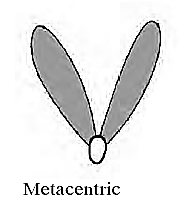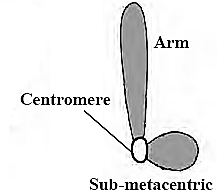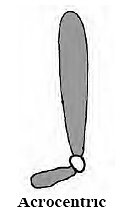Heredity and Variations
Maharashtra Board-Class 9-Science & Technology-Chapter-16
Notes
|
Topics to be learn :
|
Genetics : The branch of biology which studies the transfer of characteristics of organisms from one generation to the next, and genes in particular, is called genetics.
- The specific characteristics seen in any living organisms are due to the genes transmitted from its parents to the offspring.
Inheritance : The tendency to transmit the variations from one generations to the next is called inheritance.
- Offspring produced through sexual reproduction, show more variations. Those produced through asexual reproduction have comparatively much lesser variations.
Heredity : Transfer of characteristics from parents to offspring is called heredity.
Therefore, every living organism has similar characteristics as its parents.
- It is due to heredity that puppies are similar to dogs, squabs are similar to pigeons and infants are similar to humans.
Inherited Traits and Expression of Traits :
The characteristics and variations seen in the organisms are due to inherited characteristics.
- The inherited characters are based on chromosomes present in the cell, the DNA molecule present in the chromosome, and the sequence with which the nucleotides are arranged in the DNA molecule. Based on the sequence of the nucleotides present in the DNA molecule, a particular protein is synthesized. This segment of DNA is called a gene.
- The growth in the height of a plant depends upon growth hormone. Due to quantity of the growth hormone, the height of the plant is determined. The quantity of growth hormones produced by a plant depends upon the efficiency of the concerned enzyme. Efficient enzymes produce a greater quantity of the hormone resulting in taller plant. Thus the height depends upon the sequence of nucleotides present in the DNA.
Chromosomes : The structure in the nucleus of cells that carries the hereditary characteristics is called the chromosome.
- The chromosomes are made up of nucleic acids and proteins.
- They have hereditary characteristics located on them in the form of DNA molecule.
- The number of chromosomes is specific for every species.
Structure of chromosomes :

Types of chromosomes :
The centromere has a specific position in each chromosome. Depending upon the position of centromere and the length of the arms of the chromosome, there are four types of chromosomes.
1. Metacentric : 2. Sub-metacentric : 3. Acrocentric : 4. Telocentric :




Types of chromosomes according to their function :
D.N.A. (Deoxyribonucleic acid) : This acid was discovered by the Swiss biochemist, Frederick Miescher in 1869 while studying white blood cells.
- It is found in the nucleus and is acidic in nature; therefore it is called nucleic acid.
- DNA is present in all organisms e.g. virus, bacteria, all plants, animals and human beings.
Functions of DNA:
Structure of DNA :

Genes ; Genes are defined as the functional units of the heredity.
- The nucleotide sequence present in DNA molecule is a gene.
- Thus genes are seen on the DNA molecule.
- Genes control the structure and function of the body and help to transmit the heredity characters from parental generation to the offspring.
D.N.A. finger printing : The sequence of the genes in the DNA of a person is called a genome. By DNA finger printing technique, a person’s genome is identified. It is also used to identify the lineage and to identify criminals because it is unique to every perS0n-
Human Genome Project : In 1990, this project was together undertaken by all the geneticists of the world. In June 2000.
R.N.A. (Ribonucleic acid) :
- RNA is another important nucleic acid which is formed of ribonucleotide molecules.
- RNA is made up of ribose sugar, phosphate molecules and four types of nitrogenous bases adenine, guanine, cytosine and uracil. Instead of thymine there is uracil which is also a pyrimidine in nature.
- There is a single strand of nucleotide in RNA molecule.
Types of RNA according to their function :
Mendel’s principles of heredity : Principles of heredity are based upon this fact that genetic material is transferred from parents to offspring in equal quantity.
More than a century ago, Gregor Johann Mendel performed experiments on the pea plant and put forth the laws to explain the principles of heredity. Experiments performed by Mendel were based on seven visible characteristics of the pea plant, Pisum sativum.
Seven mutually contrasting visible characteristics : When the characteristics are sent to the next generation, they follow certain rules. The Mendel’s laws are based on these findings. Mendel’s laws are said to be the foundations of the modern genetics.
Characters
Dominant
Recessive
Shape of the seed
Round (R)
Wrinkled (r)
Colour of seed
Yellow (Y)
Green (y)
Colour of flower
Purple (C)
White (c)
Shape of the pod
Inflated (I)
Constricted (i)
Colour of a pod
Green (G)
Yellow (g)
Position of a flower
Axillary (A)
Terminal (a)
Height of a plant
Tall (T)
Dwarf (t)
Monohybrid cross : Cross between two pea plants with only one pair of contrasting characters is called monohybrid cross. The experiment and its results are shown in the Punnet Square. Gametes of P1 generation : TT = T and T, tt = t and t First filial generation : In this experiment, Mendel observed that all plants of first filial generation (F1) were tall. Even when one of the parents was dwarf, none of the offspring were dwarf. This observation made Mendel to give the principle of dominance and recessiveness. Female tt ↓ Tallness or dwarfness is the external appearance. This is called a phenotype, whereas the genetic constitution is called a genotype. F2 filial generation formed by : Self cross between F1 plants. The F2 generations show following gametes Female ↓ The genotypic ratio : In F2 the cross shows following genotypic ratio. 1TT : 2Tt : 1tt 1 Homozygous dominant : 2 heterozygous : 1 homozygous recessive Phenotypic ratio = 3 : 1 Mendel’s figures : Total plants = 929, Tall plants = 705, Dwarf plants = 224
Male TT →
T
T
t
Tt
Tt
t
Tt
Tt
Genotype
Phenotype
Characters
Type
TT
Tall
Pure dominant
Homozygous
tt
Dwarf
Pure recessive
Homozygous
Tt
Tall
Hybrid plants
Heterozygous
Male →
T
t
T
TT
Tt
t
Tt
tt
Mendel’s dihybrid cross : When two pairs of contrasting characteristics are under consideration, then it is called dihybrid cross. Round and yellow seed bearing plant was crossed with green and wrinkled seed bearing plant to have a dihybrid cross. Round and yellow are dominant characters. Green and wrinkled are recessive characters. Parental generation P1 : First parent : RR (Round seeds) + YY (Yellow seeds) Second parent : rr (Wrinkled seeds) + yy(Green coloured seeds) Gametes from RRYY parent = RY Gametes from rryy parent = ry F1 generation RRYY → rryy ↓ Genotype of these plants was RrYy, their phenotype was producing rounded-yellow seeds. F2 generation : Plants of the F1 generation of dihybrid cross produce four types of gametes RY, Ry, rY, ry. of these gametes, RY and ry are similar to those of the P1 generation. F1 first filial generation : Phenotype : All the plants formed show round and yellow seeds. Genotype : All are heterozygous RrYy. The offspring obtained through such a cross is called dihybrid. The plants with RrYy genes produced four different kinds of combinations of gametes. These are RY, Ry, rY and ry. RY, Ry, rY and ry F2 Second filial generation : Female Gamets ↓ Phenotypes :
RY
RY
ry
RrYy
RrYy
ry
RrYy
RrYy
Male Gamets →
RY
Ry
rY
ry
RY
RRYY
RRYy
RrYY
RrYy
Ry
RRYy
RRyy
RrYy
Rryy
rY
RrYY
RrYy
rrYY
rrYy
ry
RrYy
Rryy
rrYy
rryy
Dihybrid
Genotype
Phenotype
Total number
RRYY
Round-Yellow
1 (RY)
RRyy
Round-Green
1 (Ry)
RRYy
Round-Yellow
2 (RY,Ry)
RrYY
Round-Yellow
2 (RY, rY)
RrYy
Round-Yellow
4 (RY,Ry, rY, ry)
Rryy
Round-Green
2 (Ry, ry)
rrYy
Wrinkled-Yellow
2 (rY, ry)
rrYY
Wrinkled-Yellow
1 (rY)
rryy
Wrinkled-Green
1 (ry)
Ratio
1:1:2:2:4:2:2:1:1
9:3:3:1
Difference between Monohybrid cross and Dihybrid cross :
Monohybrid
Dihybrid
Crosses involving a single pair of alleles are called monohybrid crosses.
Crosses involving two pairs of alleles are called dihybrid crosses.
Monohybrid crosses yield a phenotypic ratio of 3 : 1 in the F2 generation.
Dihybrid crosses yield a phenotypic ratio of 9:3:3:1 in the F2 generation.
Genes are not assorted to form new combinations of characters.
Genes are assorted to form new combinations of characters.
Some dominant and recessive characteristics of human beings :
| Dominant | Recessive |
| Rolling tongue | Non-rolling tongue |
| Presence of hair on arms | Absence of hairs on arms |
| Black and curly hair | Brown and straight hair |
| Free earlobe | Attached earlobe |
- In each human cell, there are 46 autosomes consisting of 22 pairs of chromosomes that decide the body characters and 1 pair of sex chromosomes or allosomes that decide the sex of the individual.
- Every pair is given a number based on its length and characteristics.
- There are 44 + XX chromosomes in every cell of human females and 44 + XY chromosomes in every cell of human males.
Difference between Phenotype and Genotype : generation of a monohybrid cross is 1:2:1.
Phenotype
Genotype
It refers to the outward appearance of an individual such as shape, colour, sex, etc.
It refers to the genetic composition of an individual.
Phenotype can be observed directly in an individual.
Can be determined from the ancestry of an individual.
Individuals resembling each other may or may not have the same genotype.
Individuals possessing the same genotype usually have the same phenotypic expression.
The phenotypic ratio obtained in the F2 generation of a monohybrid cross is 3:1.
The genotypic ratio obtained in the F2
Genetic disorders : Diseases or disorders occurring due to abnormalities in chromosomes and mutations in genes are called genetic disorders.
Causes of genetic disorders :
- Changes in the number of chromosomes Increase or decrease in number.
- Deletion of any part of the chromosome.
- Translocation of chromosomes.
Disorders due to chromosomal abnormalities : Due to numerical changes 1. Down syndrome : Total chromosomes 47 (extra chromosome with the 21st pair) Causes of disorder : Trisomy 21 (46+1, Trisomy of 21st Chromosome) Symptoms : Children suffering from Down’s syndrome are usually mentally retarded and have a short lifespan. Other symptoms are, 2. Turner syndrome : Total chromosomes 45 (44+X) Causes of disorder : Symptoms : 3. Klinefelter syndrome Total chromosomes 47 (44+XXY) Causes of disorder : Symptoms :
Monogenic disorders : Disorders or diseases occurring due to mutation in any single gene into a defective one are called monogenic disorders.
(i) Albinism :
- In albinism, the body is unable to produce melanin.
- As a result, the skin becomes pale and eyes look reddish pink due to absence of melanin pigment in the retina and sclera.
- The person has white hair.
(ii) Sickle cell anaemia : Sickle cell anaemia is a monogenic disorder. The mutation in the foetus causes this disease.
- Due to mutation, the glutamic acid is changed to valine. Normal haemoglobin has glutamic acid as the 6th amino acid in its molecular structure. When it is replaced by valine, the shape/ structure of the haemoglobin molecule changes.
- This change causes oval erythrocytes or RBCs, to become sickle-shaped.
- Therefore oxygen carrying capacity of haemoglobin is reduced and clumping and destruction of erythrocytes occurs.
Symptoms of Sickle-cell anaemia : Diagnosis of sickle-cell anaemia : ‘Solubility Test’ ‘and Electrophoresis’ is performed to detect sickle cell anaemia. Remedies for sickle cell anaemia :
In Maharashtra, there are more than 2.5 lakh people suffering from sickle-cell anaemia and about 21 districts including 11 districts from Vidarbha are affected by this disorder.
Mitochondrial disorders :
Polygenic disorders : (Disorders due to mutations in multiple genes)
Inter-relationship between tobacco addiction and cancer : Tobacco is either smoked or chewed. Any kind of tobacco product is carcinogenic. Nicotine in the tobacco is the main carcinogenic agent. Harmful effects of smoking : Harmful chemicals in the tobacco smoke :
Useful links :
| Main Page : - Maharashtra Board Class 9th Science & Technology - All chapters notes, solutions, videos, test, pdf.
Previous Chapter : Chapter 15: Life Processes in Living Organisms - online Notes Next Chapter : Chapter 17: Introduction to Biotechnology - online Notes |